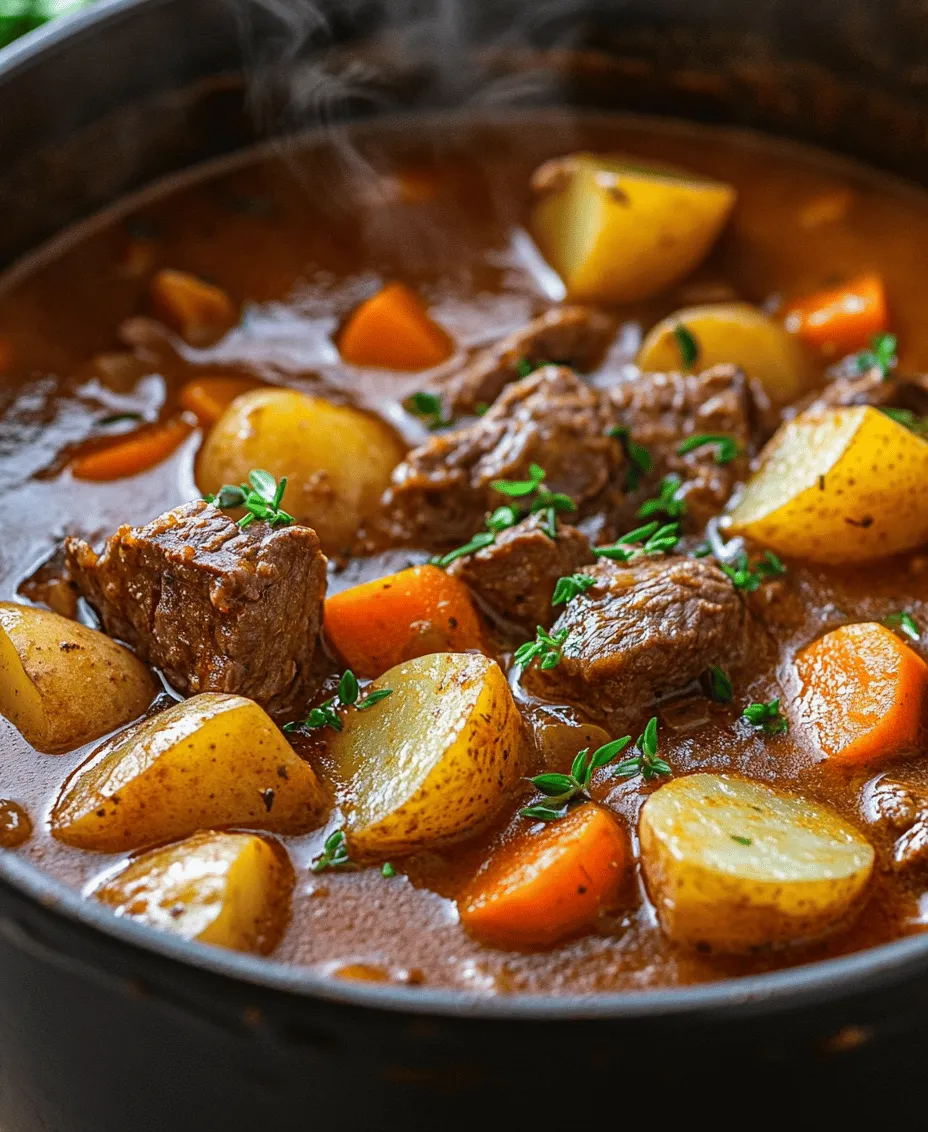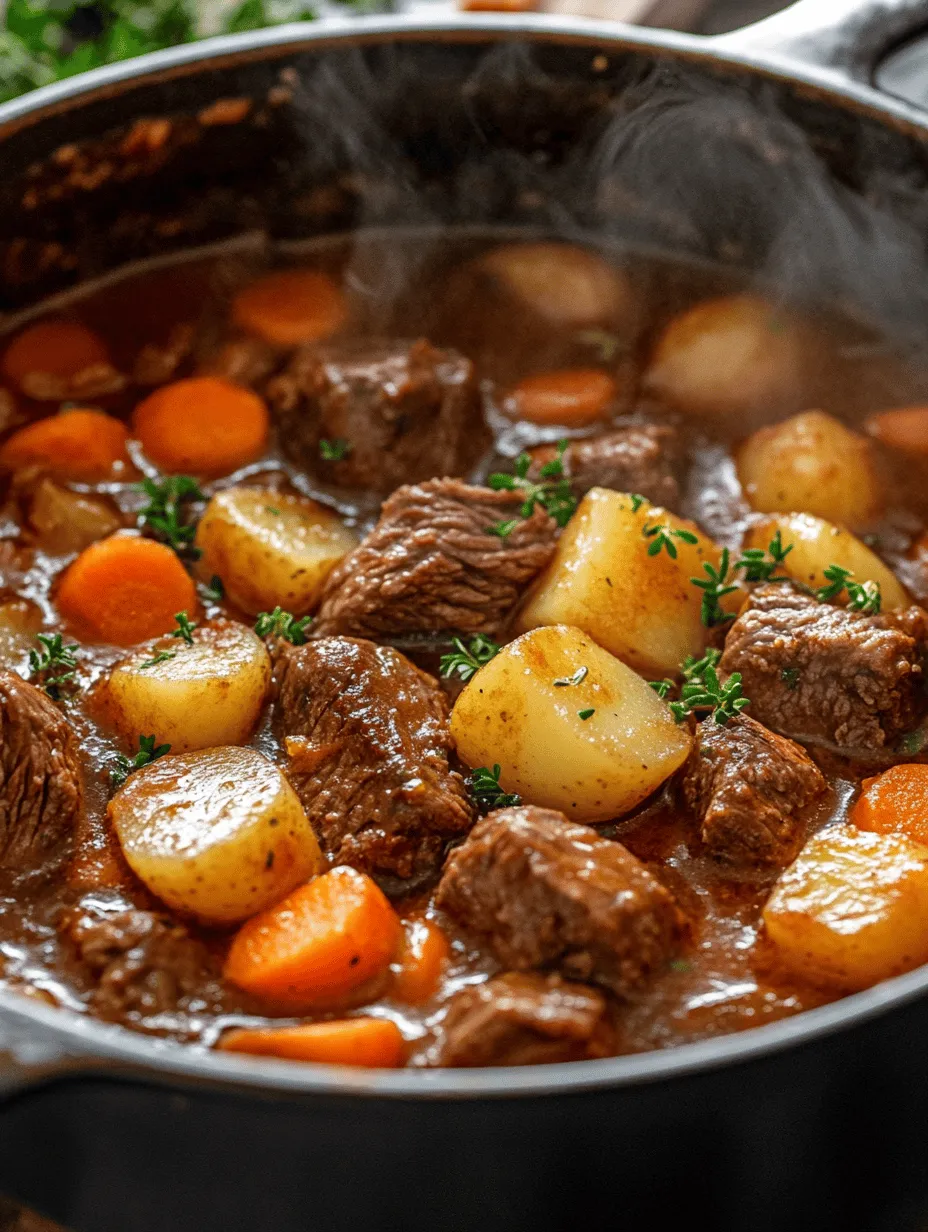Introduction
When the temperature drops and the days grow shorter, there’s nothing quite as comforting as a warm bowl of beef stew. This classic dish has been a staple in many households for generations, known for its rich flavors and satisfying nature. The beauty of beef stew lies not only in its taste but also in its ability to bring family and friends together around the dinner table, creating lasting memories over hearty meals.
Homemade meals, like this Hearty Stovetop Beef Stew, have a unique way of evoking nostalgia, reminding us of the warmth of home and the love that goes into cooking. This particular recipe stands out for its simplicity and heartiness, allowing even novice cooks to create a delicious, comforting dish that can be enjoyed on any occasion. Whether you’re preparing a cozy dinner for your family or hosting friends for a casual gathering, this beef stew is sure to impress.
The Ingredients that Make this Beef Stew Irresistible
At the heart of any great beef stew are its ingredients, each contributing to the overall flavor and texture of the dish. Let’s take a closer look at what makes this Hearty Stovetop Beef Stew so irresistible.
Beef Chuck: Description and Benefits
The star of this hearty stew is undoubtedly the beef chuck. This cut of meat comes from the shoulder area of the cow and is known for its rich flavor and tenderness when cooked low and slow. Beef chuck is well-marbled with fat, which means it retains moisture and becomes incredibly tender as it simmers in the stew. Not only does this cut deliver on taste, but it is also budget-friendly, making it a popular choice for home cooks looking to create a satisfying meal without breaking the bank.
Fresh Vegetables: Nutritional Value and Flavor Enhancement
Fresh vegetables are essential for adding both nutritional value and layers of flavor to your beef stew. Commonly used vegetables include carrots, potatoes, and celery. Carrots provide a natural sweetness that balances the savory notes of the beef, while potatoes contribute heartiness and a creamy texture as they cook down. Celery adds a subtle crunch and aromatic quality that enhances the overall flavor profile of the dish.
Incorporating a variety of vegetables not only boosts the nutritional content—packing in vitamins and minerals—but also creates a more colorful and visually appealing dish. The combination of these fresh ingredients ensures that every spoonful of your beef stew is a delicious blend of flavors and textures that will satisfy even the heartiest of appetites.
Herbs and Seasonings: Importance in Creating Depth of Flavor
A well-seasoned stew is a delicious stew, and the right herbs and seasonings can elevate your dish from good to unforgettable. For this Hearty Stovetop Beef Stew, classic herbs like thyme and bay leaves are essential for infusing the stew with earthy, aromatic notes. Thyme, with its slightly minty flavor, complements the richness of the beef perfectly, while bay leaves add a subtle depth that enhances the overall complexity of the dish.
Don’t forget about the importance of salt and pepper! They are the backbone of flavor in any savory dish, helping to enhance the natural taste of the ingredients. As you prepare your stew, don’t shy away from tasting and adjusting the seasoning to your liking.
Optional Ingredients and Their Roles
While the core ingredients listed above are crucial for a delicious beef stew, there are several optional ingredients that can add unique flavors and textures. For instance, a splash of red wine can significantly enhance the richness and complexity of your stew. The acidity from the wine helps to tenderize the beef while adding a depth of flavor that is hard to replicate with other ingredients.
Additionally, consider including frozen peas toward the end of cooking. These little green gems not only provide a pop of color but also bring a touch of sweetness that beautifully balances the savory elements of the stew. Their quick cooking time makes them a convenient addition that elevates your dish without requiring extensive preparation.
Tools You’ll Need for Perfect Beef Stew
Before diving into the cooking process, it’s important to gather the right tools to ensure a smooth and enjoyable cooking experience. Here are the essential items you’ll need for making your Hearty Stovetop Beef Stew.
Essential Cookware: Dutch Oven
A Dutch oven is your best friend when it comes to stovetop cooking, especially for dishes like beef stew that benefit from even heat distribution and moisture retention. This heavy-duty pot is perfect for searing the beef and simmering the stew, making it an indispensable tool in your kitchen. The cast iron construction allows for excellent heat retention, ensuring that your stew cooks evenly and develops rich flavors as it simmers away. If you don’t have a Dutch oven, a heavy-bottomed pot will also work, but be sure to monitor the heat closely to prevent scorching.
Kitchen Utensils
In addition to your Dutch oven, a few essential kitchen utensils will make your cooking process more efficient. A sharp knife and cutting board are crucial for preparing your vegetables and cutting the beef into bite-sized pieces. Having a sharp knife ensures clean cuts and makes the prep work much easier.
A ladle is also a handy tool for serving your hearty stew. Not only does it scoop the stew with ease, but it also allows you to serve generous portions to your family or guests. A sturdy wooden spoon will come in handy for stirring the ingredients together as they cook, helping to build that wonderful depth of flavor as you layer the ingredients.
Step-by-Step Preparation of Hearty Stovetop Beef Stew
Now that you have your ingredients and tools ready, it’s time to dive into the step-by-step preparation of your Hearty Stovetop Beef Stew. Follow these detailed instructions to ensure that your stew turns out perfectly every time.
Step 1: Searing the Beef
Begin by cutting your beef chuck into 1 to 1.5-inch cubes. It’s important to ensure that the pieces are uniform in size for even cooking. Once cut, pat the beef dry with paper towels and season generously with salt and pepper.
Heat a tablespoon of oil in your Dutch oven over medium-high heat. Once the oil is shimmering, add the beef in batches, being careful not to overcrowd the pot. Searing the beef is a crucial step; it develops a rich, brown crust on the meat, which adds depth of flavor to your stew. Allow the beef to brown on all sides, approximately 4-5 minutes per batch. Once browned, remove the beef from the pot and set it aside on a plate.
Step 2: Sautéing Aromatics
With the beef removed, it’s time to build the flavor base of your stew. In the same pot, add a bit more oil if necessary and toss in your chopped onions and minced garlic. Sauté these aromatics for about 3-4 minutes, or until the onions become translucent and fragrant. The sweetness of the onions and the pungency of the garlic will create a wonderful foundation for your stew, enhancing its overall flavor profile.
Step 3: Incorporating Vegetables
Once the aromatics are softened, it’s time to add your chopped carrots and celery. Stir the vegetables into the pot and allow them to cook for another 3-4 minutes. This step helps to release their natural sugars and further build the flavor of your stew.
Next, add the cubed potatoes to the pot. Potatoes are a key ingredient in beef stew, providing heartiness and comfort. Stir everything together, allowing the veggies to mingle and soak up the flavors from the pot.
Step 4: Combining Ingredients
Now that your vegetables are sautéed and aromatic, it’s time to reintroduce the browned beef back into the pot. Carefully add the beef along with any accumulated juices from the plate. This ensures that all of that deep, concentrated flavor makes its way into the stew.
To complete the base of your stew, pour in your beef broth, ensuring that all ingredients are covered. This is also the time to add your herbs—bay leaves and thyme—along with any optional ingredients like red wine. The combination of broth and wine creates a rich liquid that will simmer and infuse the beef and vegetables with incredible flavor.
As you bring the stew to a gentle boil, reduce the heat to low, cover the pot, and let it simmer. The magic of stovetop beef stew happens here, as the flavors meld together and the beef becomes tender. Remember to stir occasionally and keep an eye on the liquid level, adding more broth or water as needed to prevent the stew from drying out.
With each step, you are crafting a dish that is not only flavorful but also filled with love and care, making your Hearty Stovetop Beef Stew a true celebration of home cooking. Enjoy the process, and prepare for the delightful aroma that will soon fill your kitchen, inviting everyone to gather around the table for a delicious meal.

Simmering Process: Importance of Low and Slow Cooking for Tenderness
The key to a delicious and comforting beef stew lies in the simmering process. Cooking your stew on low heat for an extended period allows the collagen in the meat to break down, resulting in tender, melt-in-your-mouth bites. Low and slow cooking not only enhances the texture of the beef but also allows the flavors from the ingredients to meld together beautifully, creating a rich and satisfying broth.
To achieve the perfect simmer, bring your stew to a gentle boil after adding all your ingredients, then reduce the heat to low. Cover your pot with a lid, leaving it slightly ajar to allow steam to escape, and let it simmer for at least one and a half to two hours. Stir occasionally to prevent sticking and ensure an even cook. You’ll know your stew is ready when the meat is fork-tender and the vegetables are soft yet hold their shape.
Final Touches: Adjusting Seasoning and Adding Garnishes
Once your stew has simmered to perfection, it’s time for the final touches. Taste the broth and adjust the seasoning as needed. A pinch of salt can elevate the flavors, while a dash of pepper adds a subtle kick. If you desire a bit of acidity to balance the richness, a splash of balsamic vinegar or a squeeze of fresh lemon juice can work wonders.
Garnishing your beef stew is a simple way to enhance its presentation and flavor. Fresh herbs such as chopped parsley or thyme sprinkled on top just before serving not only add a pop of color but also a fresh aroma. You might also consider adding a dollop of sour cream or a sprinkle of grated cheese for extra richness.
Understanding Cooking Techniques Used in This Recipe
Searing: Science Behind Browning Meat
Searing is a critical step in making your beef stew. This cooking technique involves cooking the meat at a high temperature until a brown crust forms on the surface. The Maillard reaction, which occurs during this process, is responsible for the deep flavors and appealing color of the beef. Searing not only enhances taste but also locks in moisture, ensuring that your meat remains juicy throughout the cooking process.
To sear your beef effectively, do so in batches to avoid overcrowding the pot, which can cause the meat to steam rather than brown. Allow the beef to cook undisturbed for a few minutes on each side before flipping it to achieve that rich, golden-brown crust.
Sautéing: Methods to Release Flavors from Aromatics
The next crucial technique is sautéing, which involves cooking the aromatics such as onions, garlic, and celery in the rendered fat from the seared beef. This step is essential for developing the stew’s base flavor. Sautéing the aromatics until they are soft and translucent allows them to release their natural sugars, which sweeten the dish and deepen the overall flavor profile.
Make sure to scrape the browned bits (fond) from the bottom of the pot while sautéing, as these bits are packed with flavor and will enrich your stew’s broth.
Simmering: How Slow Cooking Transforms Ingredients
Simmering, as previously mentioned, is about allowing time and heat to work together. This method transforms the ingredients, allowing flavors to meld and develop while tenderizing the meat. The low, steady heat breaks down tough fibers and collagen, turning what might have been a chewy piece of beef into something succulent. Additionally, the vegetables release their starches, thickening the stew naturally and contributing to a hearty, satisfying texture.
Nutritional Benefits of Homemade Beef Stew
Making beef stew at home not only assures you of its comforting taste but also offers numerous health benefits. By selecting fresh ingredients, you can control the quality and nutritional value of your meal. Homemade beef stew is rich in protein, essential vitamins, and minerals from the vegetables and meat, making it a balanced option for dinner.
Breakdown of Calories, Proteins, and Essential Nutrients in the Stew
A typical serving of homemade beef stew contains roughly 350-450 calories, depending on the ingredients used. This dish is a great source of protein, with each serving providing around 30 grams of protein, thanks to the beef. The vegetables contribute dietary fiber, vitamins A and C, potassium, and other minerals that are integral to a healthy diet.
Importance of Homemade Meals in Dietary Control and Health
Cooking at home allows you to manage portion sizes, reduce sodium and preservatives found in store-bought options, and incorporate a variety of vegetables for added nutrients. Homemade meals like beef stew are not only nourishing but also an opportunity to create a wholesome dining experience that fosters health and well-being.
Pairing Suggestions for a Complete Meal
To complement your hearty stovetop beef stew, consider serving it with a variety of side dishes that enhance the overall dining experience.
Best Side Dishes to Accompany Beef Stew
1. Crusty Bread: A warm, crusty loaf is perfect for dipping into the rich broth of your stew. It soaks up the flavors and adds a delightful texture contrast.
2. Salad Options: A light, refreshing salad can provide a nice balance to the hearty stew. Consider a simple mixed greens salad with a vinaigrette, or a classic Caesar salad to add some crunch and freshness.
3. Roasted Vegetables: Serve a side of roasted seasonal vegetables for an additional layer of flavor and nutrition. Carrots, Brussels sprouts, or parsnips would complement the stew beautifully.
Customizing Your Hearty Stovetop Beef Stew
One of the joys of making beef stew is the flexibility it offers. You can easily customize the recipe to suit your tastes and dietary preferences.
Suggestions for Ingredient Substitutions
– Alternative Meats: While beef is traditional, you can use lamb, pork, or even chicken for different flavor profiles.
– Seasonal Vegetables: Incorporate whatever vegetables are in season or that you have on hand. Root vegetables like turnips, parsnips, or even sweet potatoes can add unique flavors.
– Adjusting Spice Levels: If you prefer a bit of heat, consider adding crushed red pepper flakes or a dash of cayenne to the stew. Conversely, for a milder dish, omit any spicy ingredients.
Storing and Reheating Leftover Beef Stew
Making a large batch of beef stew means you’ll likely have leftovers, which is a great way to enjoy this comforting dish multiple times throughout the week.
Best Practices for Storing Stew to Maintain Freshness
Store your beef stew in an airtight container in the refrigerator for up to 3-4 days. If you wish to keep it longer, consider freezing it in portion-sized containers. Make sure to leave some space at the top of the container, as the stew may expand while freezing.
Reheating Methods to Preserve Flavor and Texture
When it’s time to enjoy your leftovers, reheat the stew gently on the stovetop over low heat, stirring occasionally. If the stew has thickened too much in the refrigerator, add a splash of broth or water to reach your desired consistency. Alternatively, you can use a microwave, heating in short intervals and stirring in between to ensure even warming.
Conclusion
This hearty stovetop beef stew embodies the perfect combination of warmth, comfort, and nourishing qualities. With its rich flavors and tender meat, it’s sure to become a beloved staple in your household. The joy of cooking and sharing meals with loved ones is truly special, and there’s something magical about gathering around the table to enjoy a steaming bowl of stew.
Whether it’s a chilly evening or a family gathering, this beef stew is a satisfying choice that caters to both traditional and modern palates. So gather your ingredients, follow the steps, and enjoy the process of creating a meal that not only fills the stomach but also warms the heart. Dive into this culinary experience and savor every bite of your homemade hearty stovetop beef stew!

